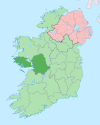
A glen is a valley, typically one that is long and bounded by gently sloped concave sides, unlike a ravine, which is deep and bounded by steep slopes. The word is Goidelic in origin: gleann in Irish and Scottish Gaelic, glion in Manx. The designation "glen" also occurs often in place names. Glens are appreciated by tourists for their tranquility and scenery.

Glengarriff is a village of approximately 140 people on the N71 national secondary road in the Beara Peninsula of County Cork, Ireland. Known internationally as a tourism venue, it has a number of natural attractions. It sits at the northern head of Glengarriff Bay, a smaller enclave of Bantry Bay.

Kinvara or Kinvarra is a sea port village in the southwest of County Galway, Ireland. It is located in the civil parish of Kinvarradoorus in the north of the barony of Kiltartan. Kinvarra is also an electoral division.

Carran, also Carron, is a small village in County Clare, Ireland. It is in the Burren region, within a civil parish of the same name. It is notable mainly for being the birthplace of Michael Cusack, the inspirer and co-founder of the Gaelic Athletic Association. At the time of the 2011 Census, Carran had 106 inhabitants.

Strokestown, also known as Bellanamullia and Bellanamully, is a small town in County Roscommon, Ireland. It is one of the 27 designated Heritage Towns in Ireland. Located in the part of the country marketed for tourism purposes as Ireland's Hidden Heartlands, it is 140 km (87 mi) from Dublin and 120 km (75 mi) from Galway. Strokestown is one of Ireland's few planned towns, showing evidence of deliberate planning, such as formally aligned streets and prominent public buildings.

Spiddal, also known as Spiddle, is a village on the shore of Galway Bay in County Galway, Ireland. It is 18 kilometres (11 mi) west of Galway city, on the R336 road. It is on the eastern side of the county's Gaeltacht and of the Connemara region. According to the 2022 census, approximately 75% of the population are Irish-speaking and, of these, approximately 40% speak Irish on a daily basis outside the education system. It is a centre for tourism with a beach, harbour, and shore fishing. The village is part of the civil parish of Moycullen.

Abbeyfeale is a historic market town in County Limerick, Ireland, near the border with County Kerry. The town is on the N21 road from Limerick to Tralee, some 21 kilometres south-west of Newcastle West and 16 kilometres south-east of Listowel and 38 kilometres north-east of Tralee. The town is in a civil parish of the same name.

Clara is a town on the River Brosna in County Offaly, Ireland. It is the 10th largest town in the midlands of Ireland. The town had a population of 3,403 as of the 2022 census.

Ballyfarnon is a village in northern County Roscommon, Ireland. Built on the River Feorish at the foot of Arigna Mountain, it lies between Loughs Skean and Meelagh with Lough Arrow, Lough Allen, Lough Bo and Lough-na-Sool nearby. It lies on the Sligo/Leitrim R284 regional road on the border with County Sligo.

Rosmuc or Ros Muc, sometimes anglicised as Rosmuck, is a village in the Conamara Gaeltacht of County Galway, Ireland. It lies halfway between the town of Clifden and the city of Galway. Irish is the predominant spoken language in the area, with the electoral division of Turlough, Rosmuc, representing one of the highest percentages of Irish-speaking people in the country. The townland of Rosmuck is part of the civil parish of Kilcummin.
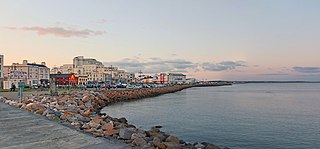
Salthill is a seaside area in the city of Galway in the west of Ireland. Lying within the townland of Lenaboy, it attracts tourists all year round. There is a 2 km long promenade, locally known as the Prom, which overlooks Galway Bay and has several bars, restaurants and hotels.
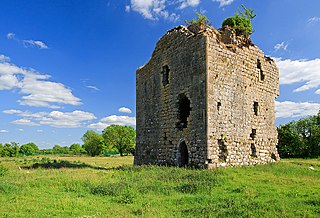
Corofin or Corrofin is a village and parish in County Galway, Ireland, situated on the N17 road between Galway City and Tuam.
Annaghdown GAC is a Gaelic Athletic Association club based in County Galway, Ireland. The club is a member of the Galway GAA and was founded in 1887. Underage teams in both hurling and football play in the Galway league and championships. Annaghdown are a dual club and cater for Gaelic football, hurling and Ladies football. There was a camogie club in the parish in times past when Corrandrum fielded a team, but the ladies of the parish now play camogie with Carnmore, Turloughmore or Castlegar clubs.
Kilkerrin-Clonberne is a Gaelic Athletic Association club based in Clonberne, County Galway, Ireland.
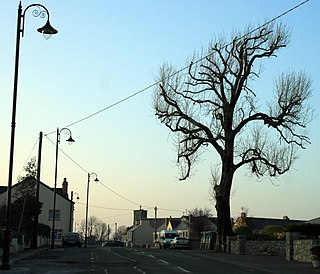
Kilkerrin is a village in County Galway, Ireland. It is situated on the R364 regional road 6 km south of the town of Glenamaddy. Features in the area include Kiltullagh Lake and the Lough Lurgeen raised bog.
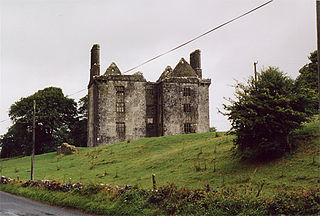
Glinsk is a small village in County Galway, Ireland, between Creggs and Ballymoe. Glinsk is located approximately 68 km from Galway city and approximately 30 km from Roscommon. It is located in valley of the River Suck, which has a 60-mile hiking trail. Nearby is the Glinsk Castle ruin, built by Ulick Burke in the early 17th century. Also in the area is the ruins of Ballynakill Abbey, which dates from the early 13th century. See Burke Baronets.
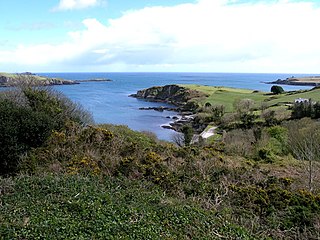
Castlehaven is a civil parish in County Cork, Ireland. It is located in West Cork, approximately 45 miles south-west of Cork City on the coast. The civil parish includes the town of Castletownshend and the hamlets of Rineen and Tragumna. The area's Gaelic football club, Castlehaven GAA, has claimed several Munster Senior Club Football Championship titles.
All Saints Gaelic Athletic Club is the only Gaelic Athletic Association club in the town of Ballymena, County Antrim. The club is a member of the South-West Antrim division of Antrim GAA, and competes in Gaelic football, hurling, Ladies Gaelic football and camogie.

Glin is a village in the northwest of County Limerick, Ireland. It is on the south shore of the River Shannon's estuary, on the N69 road between Foynes and Tarbert. The population of the village at the 2022 census was 644.
John Geraghty is an Irish former Gaelic footballer who played at club level with Kilkerrin, Mountbellew–Moylough and Fr Griffin's and at inter-county level with the Galway senior football team. He usually lined out as a goalkeeper.



















